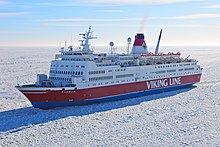
The Type II U-boat was designed by Nazi Germany as a coastal U-boat, modeled after the CV-707 submarine, which was designed by the Dutch dummy company NV Ingenieurskantoor voor Scheepsbouw Den Haag (I.v.S) and built in 1933 by the Finnish Crichton-Vulcan shipyard in Turku, Finland. It was too small to undertake sustained operations far away from the home support facilities. Its primary role was found to be in the training schools, preparing new German naval officers for command. It appeared in four sub-types.
Vesikko is a submarine, which was launched on 10 May 1933 at the Crichton-Vulcan dock in Turku. Until 1936 it was named by its yard number CV 707. Vesikko was ordered by a Dutch engineering company Ingenieurskantoor voor Scheepsbouw in 1930 as a commercial submarine prototype, being the prototype for the German Type II submarines. Purchased by the Finnish before World War II, she saw service in the Winter War and Continuation War, sinking the Soviet merchant ship Vyborg as her only victory. After the cease-fire with the Allies in 1944, Vesikko was retired. Finland was banned from operating submarines after the war and she was kept in storage until she was turned into a museum ship.

The Finnish maritime cluster is a cluster of Finnish companies in maritime industries. In 2016 the total turnover was estimated at 13 billion euros and it employed 48,000 people.
NV Ingenieurskantoor voor Scheepsbouw, usually contracted to IvS, was a Dutch dummy company set up in The Hague and funded by the Reichsmarine after World War I in order to maintain and develop German submarine know-how and to circumvent the limitations set by the Treaty of Versailles. The company designed several submarine types for paying countries, including the Soviet S-class submarine, as well as the prototypes for the German Type II submarines and Type VII submarines.
Name Turku shipyard usually means either of the following yards in Turku, Finland:

Hietalahti shipyard is a shipyard in Hietalahti, in downtown Helsinki, Finland. Since 2019, it has been operated by a company named Helsinki Shipyard.

The Vetehinen-class submarine was a Finnish 500-tonne submarine class of three vessels that was designed and built in the 1920s and early 1930s. The Vetehinen class served in the Finnish Navy during World War II. The class was designed by the Dutch front company Ingenieurskantoor voor Scheepsbouw den Haag (I.v.S) and built by the Finnish Crichton-Vulcan shipyard in Turku. The class was based on the German World War I Type UB III and Type UC III submarines and served as prototype for Type VII submarines.

STX Finland Oy, formerly Aker Yards Oy, was a Finnish shipbuilding company operating three shipyards in Finland, in Turku, Helsinki and Rauma, employing some 2,500 people. It was part of STX Europe, a group of international shipbuilding companies owned by the South Korean STX Corporation.
The Okhta shipyard was a Russian shipyard based in Saint Petersburg. It was located in the Malaya Okhta district Russian Empire. at the confluence of the Okhta and Neva rivers.
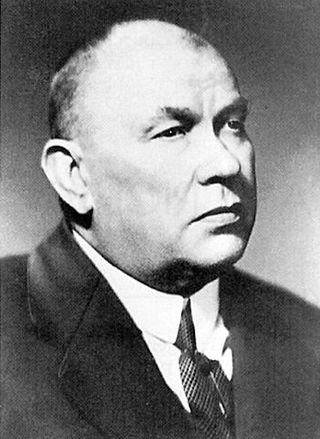
Allan Walfrid Staffans was a Finnish technician, vuorineuvos and shipbuilder.
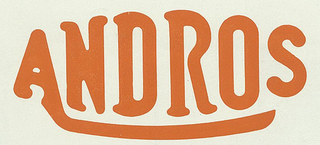
Oy Andrée & Rosenqvist Ab was a boat building yard and engineering works in Turku, Finland in 1906–1939. The company was known for its fast and high-quality boats and also marine engines, which were also applied in stationary use.

Aktiebolaget Vulcan was an engineering works and shipbuilding company that operated in Turku, Finland between 1898 and 1924.
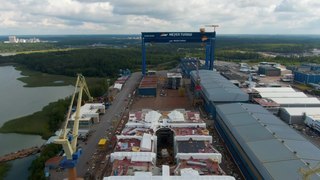
Perno shipyard is a shipyard in Turku, southwest Finland, that specialises in building cruise ships, passenger ferries, special vessels and offshore projects. The yard area is 144 hectares. The yard is operated by Meyer Turku Oy. The dry dock is 365 metres (1,198 ft) long, 80 metres (260 ft) wide and 10 metres (33 ft) deep, and equipped with two bridge cranes with capacities of 600 tonnes and 1,200 tonnes. The newer bridge crane with a capacity of 1,200 tonnes is the largest in the Nordic region.

Åbo Skeppswarfs Aktie Bolaget was a shipbuilding company that operated in Turku, Finland Proper, in 1741–1883.

W:m Crichton & C:o Ab is a former engineering and shipbuilding company that operated in Turku, Grand Duchy of Finland in 1842–1913. The company also had another shipyard in Okhta, Saint Petersburg.
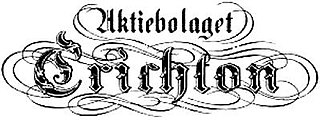
Aktiebolaget Crichton was a shipbuilding and engineering company that operated in 1914–1924 in Turku, Finland. The main products were vessels, steam engines and combustion engines.

Meyer Turku Oy is a Finnish shipbuilding company located in Turku, Finland Proper. The company is fully owned by German shipbuilder Meyer Werft GmbH. The main products are cruise ships and cruiseferries.

Aktiebolaget Sandvikens Skeppsdocka och Mekaniska Verkstad was a Finnish shipbuilding and engineering company that operated in Helsinki in 1895–1938. The company was set up to continue shipbuilding at Hietalahti shipyard, after its predecessor Helsingfors Skeppsdocka, which operated the yard in 1865–1895, had bankrupted.

Turku Repair Yard Ltd is a Finnish ship repair company. Its premises are situated in Luonnonmaa island, Naantali. The company has focused on repairing of ships and boats.




